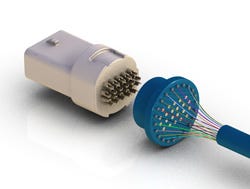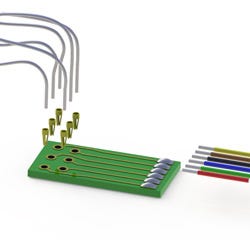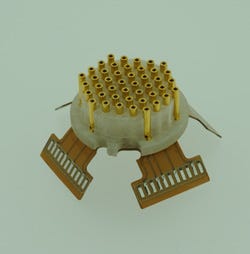Automating fine wire termination can reduce assembly times and improve yields when manufacturing medical connectors.
July 16, 2012
Rapid wire termination technology makes connecting wires to a connector substrate as easy as making connections on a PC board substrate. The process is inexpensive and quick, and yields high quality with automatic machines or quick hand soldering. Devices with 100 or more connector pins in a square centimeter are now possible.
 |
1. Automated rapid fine-wire termination technology, showing terminal block in middle. |
The automation of fine wire termination provides for reduced assembly times, improved yields, and improved field reliability in what has traditionally been the most time consuming and costly production activity in manufacturing medical connectors. The time and labor-intensive assembly problems associated with fine wire terminations in complex medical connectors are cost effectively resolved.
Automated Rapid Wire Termination Technology
Essentially, rapid wire termination technology is an automated procedure for connecting wires from one area of a PCB (or termination block) to another. A termination block is an area on a board where wires can be connected.
Although technicians can manually solder 40-guage wires to connector pins using microscopes and fine precision tools, the need for greater miniaturization, reliability, reduced production cost drives the need for automated rapid fine-wire termination technology. In addition, rapid wire termination can introduce greater sophistication in medical device probes.
As the number of wires from medical device probes increases, the size of the probes continues to decrease, and so must the size of the terminating wires. Connector engineers must routinely work with 40-gage with 50-gage wire capabilities readily available.
Catheters and other minimally invasive medical probes are not the only applications that use rapid fine-wire termination technology, but these medical devices challenge miniaturization. Modern catheters may contain more than 120 40-gage wires connecting medical transducers. It’s imperative that each of these wires be terminated and strain relieved.
Rapid fine-wire termination permits smaller wires to be reliably soldered in a fraction of the time and cost of manual soldering. Rapid wire termination can be an automated process, which reduces soldering time, eliminates cold solder joints and burnt insulation, and greatly reduces process time. Quality interaction can be reduced down to spot-checking.
|
2. Fine wires are rapid terminated to a block, ready for press fitting to connector plug. |
Many requirements of the soldering process can be eliminated completely. Each automated rapid fine-wire connection is extremely reproducible. A skilled operator only needs to check the process periodically with specialized-but-readily-available instrumentation to ensure quality. The automation engineering staff can immediately address problems.
Probes and catheters can be electronically connected and capabilities enhanced, but they aren’t the only options. Figure 2 shows a cable with multiple wires connected by rapid wire termination to a blue male connector. The blue connector can be inserted in a shell with a strain relief to secure the cable.
Rapid wire termination technology can be used to place personality resistors on the same platform as the rapid fine-wire termination block to key different interfaced equipment for proper operation with different cable assemblies. The value of these resistors is sensed by the interfaced equipment, which then determines the proper connections that are made for a particular cable. The resistors thus tell another circuit the characteristics or personality of the equipment it is interfacing. Different cable assemblies can be used with different interface equipment, meaning increased flexibility and reduced costs.
Automated rapid wire termination technology offers significant medical connector functionality beyond what is in use today. Future medical electronics instruments could have intelligence built into their connectors, with system upgrades introduced through drop-in replaceable connectors. Combining different sized wires embedded electronic components with solder and solderless to fine wires terminating in a single connector makes it possible for medical device OEMs to embed value added, intelligent, microscale systems into their connector designs, dramatically enhancing capabilities that can be introduced from the connector.
|
3. Transition from tungsten to beryllium copper wires in a rapid wire termination connector. |
Solving Connector Production Problems
Soldering 40-gauge wire to standard pinned receptacles presents a burn risk to technicians when constructing cable assemblies. A rapid fine-wire termination block can be designed to eliminate such safety concerns and increase throughput by greatly cutting soldering time.
A common manual process quality control issue appears in the manual soldering process, which requires heating pins to a specific temperature so that the solder joint is not left cold. The process can damage wire insulation. Rapid fine-wire termination solves this problem becuase it uses reflow solder technology that applies heat quickly to small point.
Medical device probes that carry RF electrical energy at 1000 V ac to ablate tissue can require welding beryllium copper wires to tungsten wires. In addition, tungsten wires are needed to withstand the heat generated at the probe’s tip. By making a transition from tungsten to beryllium copper wires in a connector and then bringing the beryllium copper wire to a rapid wire termination block, tungsten, or any dissimilar metal wires, can be inserted into beryllium copper pins, which are then inserted into plated through-holes to form low resistance connections. The PCB can then complete the connection to copper wires.
Beryllium copper female contacts can be press fit into plated through-holes, forming the solderless rapid wire termination block. The spring action and low electrical resistance pins ensures a tight fit and the ability to carry the 5-amps needed to heat the probe.
Rapid wire termination is an extension of printed circuit fabrication automation. Many wires are separated and cut to a precise length and striped so that they meet a solder ball lattice produced on a surface mount board.
Alternately, the striped wires can be pushed through plated through-holes and reflow soldered. The striped wires can also be inserted into copper beryllium female contacts and press-fitted into plated through-holes. This method can be done automatically or manually in the field without special tools. The method can also be used to make transitions to wires that are dissimilar to copper wires.
Rapid wire termination is a versatile procedure that can connect any size wires from 20-gage to 50-gage in any pattern. A bundle of 120 40-gage wires can be connected to a solder ball array in dimensions of less than a square centimeter. Engineers should handle a solder ball array, also known as a rapid fine-wire termination block similar to any surface-mount component.
|
4. Termination block connector to a PCB edge, where larger wires needed to supply power. |
Combining Rapid Wire Termination With Embedded Electronics
Wires can be directly connected to a set of pins or, if the connector platform is a surface-mount PCB, to passive or active components on the PCB. A simple passive component jumper on a connector can enable power or indicate to another piece of equipment that it is ready to function. Essentially, such a feature acts as an interlock to indicate to another module in the system when it is safe for the system to power up.
One of the problems of suddenly plugging into a connector delivering power is latchup—essentially active devices become stuck and cannot function. Latchup can be caused by voltage rails coming up sporadically or by a capacitance or inductor generating a voltage spike. Voltages across a usually reverse-bias junction can cause the junction to become forward-biased, which creates an inherent diode and holds another component in a state until the voltage is removed. Worse, these voltage differences can exceed the rating of a component and permanently damage it. Embedding components into the connector can solve such problems.
Active embedded components can give the probe additional intelligence and make it more sophisticated. Active components in the connector supply side can deliver voltage when an enable jumper in the connector load side is detected. The voltages can be ramped up in an orderly fashion so as not to cause latchups or cause break down damage. Telling the power source that it is ready for power-up makes the connector hot pluggable—that is, it can be plugged in without consideration of the power status of the rest of the system.
Medical technicians working under pressure in an OR or ICU should not have to be concerned with powering down equipment to swap out devices. This is a dilemma, since many state-of-the-art electronic components require more power-up care. State of the art processors such as the Intel i7 core and large memories employing high-density semiconductor technology operate on low voltage supplies and are more sensitive to voltage spikes.
|
5. Close-up of connections to fine wire termination block. |
These problems can be solved by designing the power supply to control the order of voltage rails sequencing up and the ramp-up rate once the power source has detected the embedded pin-to-pin jumper in the connector. The problem of hot plugability can also be avoided by using active components on the connector’s substrate to ramp-up and properly sequence the voltages. This solution can also be applied to a situation in which the power source was not originally designed to apply power gently.
Photo 4 shows a fine-wire termination block connector to a PCB edge. It is capable of handling mixed wire sizes. Larger wires such as 20 AWG might be needed to supply power to the devices the cable will be connected to, or the active components to be placed on the connector substrate. Some signal wire could be as small 50 AWG.
Active, embedded-on-the-connector components can include op-amps to boost signals, raise input impedances, or lower their impedance to overcome EMI or RFI. Digital components can also be added to this platform. Designers can add a/d convertors, for example, to digitize signals. Multiplexers can be added to merge the signals under the control of an on board processor so that the digital signals can be fed out to fewer pins.
Some physiological signals are particularly challenging due to their low level. EKG originates in millivolts and EGG originates in microvolts. Besides placing active amplifying components at the connector level, rapid wire termination blocks permit surrounding sensitive inputs with ground plains tied to shields. This method not only helps eliminate EMI and RFI, but also helps eliminate 60 Hz capacitive coupled noise.
Combining Rapid Wire Termination With Compliant Pins
Rapid wire termination blocks can be combined with compliant pin technology. Compliant pins insert in plated through-holes with significantly improved characteristics over the usual “eye-of-the needle” pins because compliant pins are designed to slide into plated-through-holes and exert spring like action in all directions. This evenly applied force eliminates scraping of plating that can create debris, leaving a clean and secure but removable connection.
Combining compliant pin, rapid wire termination technologies and the ability to add components to the connector substrates can produce many advantages. A board-to-board flexible cable can be implemented, and because the female receptacle is just an array of plated-through-holes, the cable can have components to adapt it to different boards. Modifications can be added to update or fix board functions, eliminating redesigning and manufacturing new boards. An updated cable can be installed in the field to bring the system up to date.
Working With Rapid Wire Termination Technology
The main concept of rapid wire termination is to connect probes or cables by reliable automatic repeatable procedures. Because the fabrication procedure is not labor intensive, it reduces production cost. The low cost probes are thus disposable. Upgrading a system can be done by replacing the probes or cables. Changing the probe can be as simple as changing the processors algorithm stored in its PROM or changing a few components. Often a system can be upgraded in this manner without a complete FDA review. It may only require a letter-to-file documenting the upgrade.
The development of PCB and surface mount technology with automatic component insertion and soldering, of which rapid fine-wire termination is an extension, has revolutionized medical electronics and greatly increased reliability, and quality as it has reduced size and cost.
Connector manufacturing has expanded with this technology, offering medical device OEMs low cost, easy to upgrade, advanced functions built into the connector, while dramatically improving manufacturing yields, field reliability, and connector functionality.
++++++++++++++
 Dennis Johnson is President and CEO of Onanon, Inc. (Milpitas, CA). He has 20 years if engineering experience, and is active in transforming the way medical connectors are manufactured. Reach him at [email protected].
Dennis Johnson is President and CEO of Onanon, Inc. (Milpitas, CA). He has 20 years if engineering experience, and is active in transforming the way medical connectors are manufactured. Reach him at [email protected].
About the Author(s)
You May Also Like






